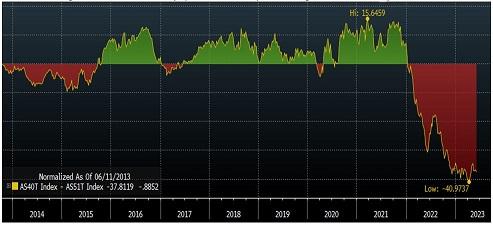June 2023 It’s been a tough time for small cap investors
by Stephen Bennie 2023-06-01

We take a closer look into the ongoing and significant underperformance of Australian smaller market capitalisation companies.
First off, a quick reminder that a listed company with a market capitalisation of less than NZ$3 billion is considered to be a 'small cap' company. And if a company has a market capitalisation of less than NZ$500 million it falls into the microcap category. In December last year I wrote an article for the NBR which went into these definitions in greater detail, and I discussed some of the attractions for an active investor to investigate the smaller end of town for potentially outperforming investments. I did also note in that article that small and micro caps can have episodes of volatile share price performance and that 2022 had been a difficult year for that asset class.
Jump forward to halfway mark of this year and small and micro caps are still struggling share price wise. Below are a couple of charts from Bloomberg that compare the returns of the S&P/ASX 200 index to the returns of the S&P/ASX Small Ordinaries (which excludes the largest ASX listed companies). This is a good proxy for comparing large cap returns to smaller cap returns. Where the line is going down, large caps are outperforming small caps and when it is going up small caps are outperforming large caps. You can see the return pendulum swung between the two for most of the last decade, right up until November 2021. Since that time, it has been one way traffic with smaller caps significantly underperforming their bigger cousins.
Chart showing the recent Australian Small cap underperformance.

Source: Bloomberg
The chart below is a very similar analysis, but this time smaller resource (Energy, Metal & Mining) companies have been excluded from the smaller cap index. So, what we have below is large caps versus smaller industrial companies. As you can see from the chart below smaller industrials are normally a good hunting ground for active investors. For most of the past decade those companies deliver better returns, with the line in green territory. Again though, it all changes from November 2021 where the outperformance is quickly wiped out and smaller caps drop sharply into deep red territory. From that point smaller cap industrial companies underperform their larger cousins by around 23%.
Chart showing Australian Small cap (ex-Resources) even larger recent underperformance.

Source: Bloomberg
So, what happened in November 2021 that triggered this significant small cap underperformance. The event that kicked off this sustained underperformance was the US Federal Reserve admission that inflation was not transitory and that they would be raising rates sooner than expected, this became known as the “Fed Pivot”. This knocked over the share market apple cart creating a wave of volatility that was further heightened by war in Ukraine and energy price shocks. Share markets around the globe dropped into bear market territory as bad news plagued investors throughout 2022. In such an environment investors will often look to hide in larger cap companies.
The rationale here is that the larger companies can be more resilient in times of crisis. The net result of this is capital flowing from small caps to large caps, which creates small cap underperformance when the market becomes highly volatile. Some investors doubtless eschew small cap investing because of this phenomenon, as you tend to underperform in a falling market, which can be an unpleasant experience in the short term. That certainly was very much the case in the Global Financial Crisis of 2008 where small caps sizeably underperformed a falling market.
Meanwhile, volatility has continued into 2023, in large part due to the collapse of a handful of US regional banks. While these banks have no direct connection to Australian equities, investor sentiment and investment themes often travel the globe. In this case it’s a one two hit for small cap companies. Obviously more volatility hurts but it looks certain that due to the US regional banks collapse, there is likely to be a systemic increase in the cost of capital and a tightening in lending standards. This is more likely to be felt by smaller companies than the larger players in the market. Hence further small cap underperformance in 2023.
Earlier I mentioned the Global Financial Crisis, as I am sure readers will remember that was an episode of extreme volatility. That level of volatility triggered another swing of investors moving from small caps to large caps. In face the biggest swing of the past two decades. At one point in December 2008 Australian small caps were underperforming Australian large caps by nearly 30%. And that was in a falling share market, so a very significant draw down for Australian small caps.
Unfortunately, that’s the sort of drop that shakes out a bunch of investors who often end up selling at very depressed levels. I say unfortunately because if they had stayed the course and held onto their small caps, there were two fantastic years of significantly outperforming a rising market in 2009 and 2010 just around the corner.
In many ways the GFC of 2008 and the following two years perfectly encapsulate the pros and cons of small cap investing. When investors are dealing with a crisis, real or perceived, they will often look to hide in large caps, even though they may look expensive. They have moved into defence mode and are more worried about risk than return. Once the crisis has passed and the world has not ended and the markets calm, investors start to become more interested in return than worrying about risk. Funnily enough small caps are cheap, having just been heavily sold off, and suddenly that’s what investors want to be owning again. We may well be seeing a similar episode playing out in the market right now.
Share article:
Other Insights
Stay updated with Castle Point Funds.
Investments
Resources
Company
Castle Point Funds
Perpetual Guardian Tower
Level 23, 191 Queen Street
Auckland 1010
PO Box 105889
Auckland 1143, New Zealand
E info@castlepointfunds.com
PG Funds Limited is the issuer and manager of the Castle Point Funds Scheme.
2025 Castle Point Funds, Inc. All rights reserved.
Privacy Policy



